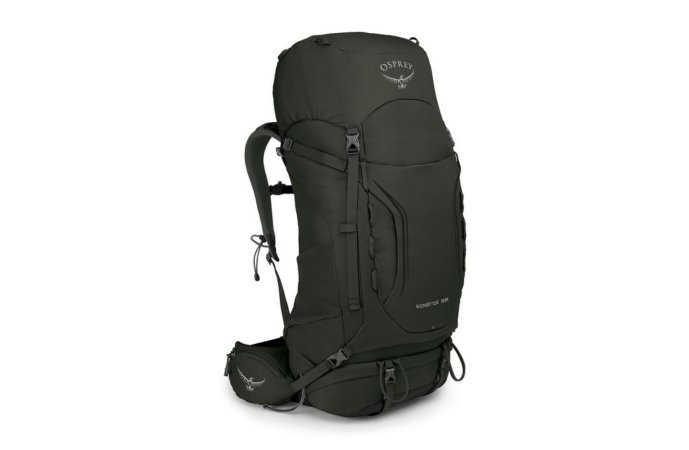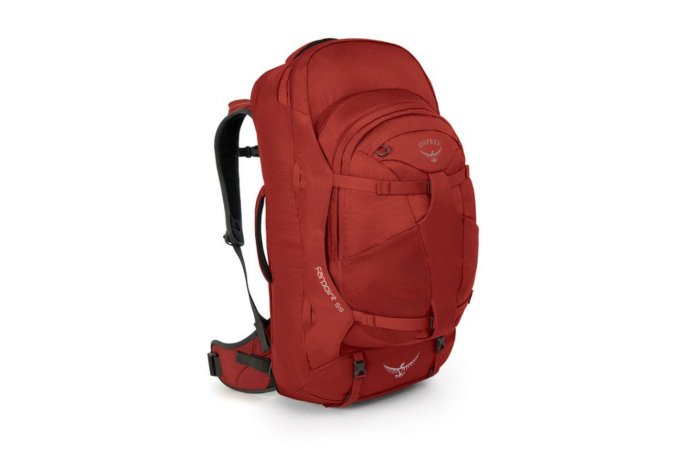

We may earn revenue from the products available on this page and participate in affiliate programs.
For nearly 50 years, Osprey backpacks have served those called to adventure into the great outdoors. The company has evolved over the years, but the brand has become the standard for backpacks in North America and much of the world. Its quality is well-known, its service is excellent, and it stands behind everything it makes with its famous lifetime “All Mighty Guarantee.”
Since its founding in 1974, the Osprey backpack product line has expanded to meet a wide variety of adventures and traveling needs. It makes so many packs for backpacking, hiking, traveling, and beyond, that it can be difficult to figure out which one best meets your needs. Fear not: We’ve done the research for you so you can choose the best Osprey backpack to take on your next journey.
- Best Overall: Osprey Atmos AG 65
- Best Budget: Osprey Rook 50
- Most Sustainable: Osprey Archeon 30
- Best Value: Osprey Kestrel 58
- Best Carry-On: Osprey Daylite Expandable 26+6
- Best Travel: Osprey Farpoint 55
- Best for Hiking: Osprey Exos 38L
Best Overall
Osprey Atmos AG 65
Pros
- Connected integrated rain cover
- Side access ports, hip belt pockets, water bottle sleeves, and hydration ports put everything you need at your fingertips without pulling everything out
- Adjustable frame
Cons
- Hip pocket zippers are difficult to close with one hand
- Some report “squeaky” frame
Product Specs
- Weight: 4.8 pounds (L/XL)
- Product dimensions: 34.65 x 15.35 x 14.17 inches
- Volume: 68L (L/XL), 65L(S/M)
- Materials: Recycled 210D nylon, PFC/PFAS-free DWR
Why It Made The Cut
- Smartly configured, durable, near-perfectly engineered, and sporting plenty of load capability, the Atmos AG 65 can be used for backpacking, camping, or traveling.
Best Budget
Osprey Rook 50
Pros
- Integrated rain cover
- Ventilated back panel
- Adjustable harness customizes fit
Cons
- Could use more pockets
Product Specs
- Weight: 3.49 pounds
- Product dimensions: 29.1 x 16.3 x 13.8 inches
- Volume: 50L
- Materials: 600D polyester (main)/1000D (bottom)
Why It Made The Cut
- This comfortable backpack comes with plenty of features and has enough room to carry you up to five days into the wilderness, but at a great price.
Most Sustainable
Osprey Archeon 30
Pros
- Fixed-lid top with internal and external zippered pockets
- Dual stretchable hip belt pockets
- Integrated rain cover
Cons
- A little heavy for a pack this size
- 30L hip belt isn’t sturdy like the larger versions
Product Specs
- Weight: 4.02 pounds
- Product dimensions: 25.98 x 11.81 x 9.45 inches
- Volume: 30L
- Materials: 1880D recycled nylon canvas
Why It Made The Cut
- Although all Osprey products are bluesign-approved, some, like the Archeon 30, are also made of mostly recycled materials, making it even more eco-friendly.
Best Value
Osprey Kestrel 58
Pros
- Adjustable torso length and breathable back panel
- Floating top lid with zippered pockets
- Spacer-mesh harness works with hip belt to comfortably distribute weight
Cons
- Heavier loads may be feel uncomfortable on extended trips
Product Specs
- Weight: 3.75 pounds (S/M), 3.88 pounds (M/L)
- Product dimensions: 30.7 x 14.2 x 13.6 inches
- Volume: 56L (S/M), 58L (M/L)
- Materials: 210D x 630D nylon dobby (main), 500D nylon packcloth (bottom)
Why It Made The Cut
- The Kestrel’s size and feature-loaded design makes it a great buy for anything from day-hiking to three- to five-day trips into the backcountry.
Best Carry-On
Osprey Daylite Expandable 26+6
Pros
- Sized to fit most airline personal carry-on guidelines
- Airscape back panel for comfort
- Expandable capacity (the “+6” part of the name)
- Trolley handle pass-through
Cons
- No separate laptop sleeve
Product Specs
- Weight: 1.85 pounds
- Product dimensions: 17 x 13 x 6 inches
- Volume: 26L
- Materials: 200D recycled polyester (main), 600D recycled polyester (accent and bottom)
Why It Made The Cut
- This smartly-engineered Osprey travel backpack is the right size and right design to help make air or rail travel a lot less stressful.
Best Travel
Osprey Farpoint 55
Pros
- Stow-away shoulder straps and hip belt
- Removable daypack with straps and harness
- Padded top and side handles for easier carrying
Cons
- Not as adjustable as an actual backpacking pack
Product Specs
- Weight: 3.75 pounds (S/M)
- Product dimensions: 24 x 13 x 12 inches
- Volume: 52L (S/M)
- Materials: 600D packcloth
Why It Made The Cut
- Of all the Osprey travel backpacks, the Farpoint series does the best job of bridging the gap between the needs of the backpacker and traveler.
Best for Hiking
Osprey Exos 38L
Pros
- Lightweight
- Adjustable torso length
- Removable floating lid
Cons
- A little pricey
- Ultralight design means fewer features
Product Specs
- Weight: 2.695 pounds (S/M), 2.827 pounds (L/XL)
- Product dimensions: 29.53 x 12.99 x 11.81 inches (S/M), 31.5 x 12.99 x 11.81 inches (L/XL)
- Volume: 38L (S/M), 41L (L/XL)
- Materials: 100D high-tenacity nylon ripstop (main and bottom)
Why It Made The Cut
- This Osprey hiking backpack is great-looking, lightweight, and perfectly-sized for long day hikes or even shorter weekend camping trips (if you know how to pack).
Things to consider before buying an Osprey backpack
Osprey makes a lot of different backpacks for hiking and backpacking, for traveling in the city and across the world. Heck, it even has Osprey baby backpacks.
When you’re deciding what Osprey backpack is best for you, ask yourself what exactly you plan on using the pack for. Do you plan to spend most of your time in the backcountry? Then a backpacking backpack is what you want. Do you need something that you can easily get through an airport? Then one of the Osprey travel backpacks designed to minimize aggravation as you go through security checkpoints and check-in stations is likely what you’re looking for.
The fantastic thing about Osprey’s products is that there are so many shared features across them. But uniting all of these packs is Osprey’s backpack warranty, the so-called All Mighty Warranty. This is its guarantee that no matter what goes wrong with your pack, no matter when you bought it, it will make it right. That’s standing behind your product.
FAQs about Osprey backpacks
Q. Where are Osprey backpacks made?
A. Osprey backpacks are made in a factory in Vietnam, but it also uses Navajo sewing personnel in Colorado who repair products as part of its lifelong All Mighty Guarantee. Plus, it has a distribution facility in Utah, as well as another office in England.
Q. How do I put a water bladder in an Osprey backpack?
A. Putting a water bladder in an Osprey pack is super easy. Nearly every Osprey backpack has a separate water reservoir sleeve on the inside part (closest to your back panel) of the main compartment. You simply need to slide the filled bladder into this sleeve, then thread the hose through the hydration port of the pack.
Q. How do I measure my torso for an Osprey backpack?
A. Ideally, you can get this done by skilled outfitters at stores like REI. But, if you’re going to go it on your own, Osprey has detailed instructions here. You’ll need to measure from your C7 vertebrae (top of spine), down to your iliac crest (the top of your hip bone). It’s not as complicated as it sounds, so check out the video if you need help.
Q. Are Osprey backpacks water-resistant?
A. Yes, to a point. Many of Osprey’s backpacks are DWR (durable water-repellent) treated, which contributes to the pack’s longevity and durability. However, they are not waterproof, which is where the rain covers come in. Oh, you wanted something waterproof? Then you may want to take a look at our best waterproof backpacks.
Final thoughts
Osprey’s quality and understanding of the needs of backpackers of all stripes has resulted in a ton of great choices, and the truth is, it has a number of backpacks that can meet a variety of needs. But the Atmos AG 65, which masterfully combines the best of all Osprey’s decades of engineering, is the clear champ for most folks.
Methodology
Not everyone plans to disappear into the wilderness for a week or more, so the award winners above had to be the best in fulfilling the needs of each particular category. Someone plane-hopping from city to city has very different needs than someone hiking the Appalachian Trail, so I took a careful look at the features offered by Osprey’s impressive number of products to make sure we recommended the best fit for you.
The recommendations in this guide were determined by combining personal experience with the brand, extensive research of buyer likes and dislikes of the various Osprey products (both by using customer reviews on REI.com, Osprey.com, and Amazon, and by digging into comments on social media forums like Facebook groups and Reddit), and then comparing our favorites to other Osprey buying guides (in this case, I looked at the thoughtful guides published by Broke Backpacker, Outdoor Crunch, and Curated.com). I also found some interesting insight at Minimalist Travel and a great, detailed comparison of the Atmos 65 versus the Aether 65 (the two titans of Osprey’s backpacking world) at 99Boulders. Learn more about our product review process.






